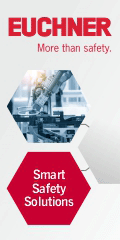
Posted to News on 27th Apr 2017, 09:37
Working with ISO/TS 15066, technical specification for cobots
ISO/TS 15066 is the international technical specification for the safe implementation of collaborative robots. This article pools experience from consultants, suppliers, integrators and end users who have worked with the technical specification. *

Further to a review of ISO/TS 15066:2016, Robots and robotic devices - Collaborative robots, and an editorial piece in the MachineBuilding.net email newsletter of April 2017, contributions have been received from people who have worked with ISO/TS 15066:2016 or PD ISO/TS 15066:2016, which is the UK equivalent published by BSI.
A machinery safety consultant's perspective
Derek Coulson, a Technical Advisor with Safe Machine Ltd, has contributed the following:
"I recently helped a company with the implementation of a cobot in a packing line. We did an initial design review, but did not complete the CE marking.
"The robot formed a box, then loaded it with boxes of product and pushed it through a tape sealer. The issues were primarily that the robot had torque levels set at a generic level. There were trapping points and sharp edges on the tooling and machine frame.
"With the cobot it seems to be the programmer's responsibility to set the levels as low as possible, and this appears to be a pain, so probably will not be done. The company we were working with had implemented cobot systems before and had not changed generic settings.
"Other issues were general: making sure that the gaps are suitable, removing sharp edges, making sure that speeds reduce when approaching tight places, and validating safety-related control systems.
"People implementing cobots need to be aware that these are machines (or form part of an assembly of machines) and need to carry CE marking to Machinery Directive 2006/42/EC and EMC Directive 2014/30/EU. Each new application of the robot could potentially require the CE marking process to be repeated, depending how the new application differs from the previous application(s). Programs should be password-protected so that only authorised personnel can make changes. Any change to the cobot program requires a risk assessment and the changes should be documented.
"In the risk assessment process, if a risk of injury is identified, even if only a minor injury, the risk should be reduced to make it as low as reasonably practicable.
"To this end, we have developed a specific checklist for Compliance Risk Software for ISO/TS 15066 that allows integrators to address all of the clauses of the technical specification in a formal manner, and carry out risk assessments as they go. It is still a requirement to address the Essential Health and Safety Requirements of the Machinery Directive, which the software will also do, but it gives a specific checklist for the cobot system, as an additional safeguard that the CE marking has been considered when developing the assembly.
"Cobots offer many advantages in a variety of different situations, but they are potentially hazardous and need to be treated with respect. Applying the principles laid down in ISO/TS 15066 will certainly help but, as an absolute minimum, people implementing cobots should conduct a formal risk assessment and take steps to reduce risks where necessary."
Suppliers' perspectives
A family of collaborative robots has been available from Universal Robots for several years, with payloads and reaches to suit different applications. Last year the company welcomed the publication of ISO/TS 15066 and has since written an article that explains the four types of collaborative operation with cobots. Furthermore, this states that the only two methods that offer industrial users significant benefits are:
- Speed and separation monitoring
- Power and force limiting
The article states: "Currently, most collaborative robots including Universal Robots are inherently designed to limit power and force. If the robot detects a certain level of power or force, the robot controller stops the robot system to protect the human operator. Due to the safety functions for motion, speed, force and power monitoring, the human and robot system can move at the same time in the same workspace. As long as the risk assessment is conducted properly, traditional guards and protective devices are not needed."
Clearly the key point is the need for a properly conducted risk assessment and, although not stated above, actions should be taken if any risks are not already low enough.
The point about risk assessments is echoed by Katherine Johnson from KUKA Robotics UK, who says "A truly collaborative robot, such as the LBR iiwa that is equipped with joint torque sensors on all seven axes, can detect contact immediately and reduce its level of force and speed, thereby ensuring compliance with ISO/TS 15066 and the underwriting of risk assessments conducted for specific applications.
"When implementing automated systems in line with the requirements in ISO/TS 15066, KUKA always provides bespoke technical specifications. This is because no two applications are the same, or carry the same risk(s) when placed within a human/machine environment.
"Compliance controls within the LBR iiwa enable it to handle heavy and/or delicate components, without creating crushing or shearing hazards, by means of adjustable resistance to suit the programmed task. This further supports the requirements of ISO/TS 15066 that dictate the maximum force or pressure that can safely be subjected to male or female operatives."
* If you have any further views on implementing collaborative robots in line with the requirements of ISO/TS 15066, please email them to [email protected] and they will be considered for inclusion on this page.
Want the latest machine building news straight to your inbox? Become a MachineBuilding member for free today >>















